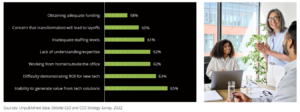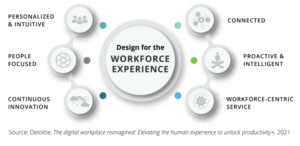Lori Lorenzo, and Bob Taylor are Managing Directors, and Lee Merovitz is a Leader at Deloitte LLP. This post is based on a Deloitte memorandum by Ms. Lorenzo, Mr. Taylor, Mr. Merovitz, and Erin Hess.
It’s not unusual for organizations to struggle with organizational change. In-house legal departments are no exception.
In the past year, more than 43% of chief legal officers (CLOs) indicated that transformation is a top priority within their legal function, with a focus on technology (86%) and strategy (14%).[1] Many of these CLOs may be heading up their organization’s transformation efforts beyond the legal department: According to a recent Deloitte survey, legal executives lead a third or more of enterprise-wide digital, workforce, and cybersecurity transformation initiatives. Meanwhile, 82% expect their workload to increase from the previous 12 months. All told, these conditions may be prompting CLOs to consider more efficient and effective ways to drive transformation in their organizations.[2]
We recently asked legal executives about possible challenges they’re facing with transformation. The most common concerns they raise are the inability to generate value from technology solutions (65%) and the difficulty of demonstrating return on investment (ROI) for new technology (63%). But most also cite a range of other challenges, from obtaining enough funding to remote work and lack of expertise (figure 1).[3]
Among legal operations professionals, a similar proportion (67%) agree that clearly and consistently demonstrating the value of their technology is an issue. They’re also concerned about expertise, with 35% agreeing that most individuals within the legal department have good technological skills. Additionally, they raise a pair of challenges that may not be on many legal executives’ radar screens: Adoption and change management, 57% say, are the biggest concerns related to technology transformation.[4]
Are legal operations professionals on to something? Could adoption and change management affect the value and return that legal teams can achieve from their technology investments? They’re interrelated concepts in that the more you design the solution to encourage adoption, the easier it should be to manage the change process overall. What does this mean from a practical standpoint? Let’s break it down.
Figure 1. Legal executive perspectives on challenges to digital transformation
Placing humans at the center of digital design
Digital technology is supposed to make it easier for people to do their jobs, but it may sometimes have the opposite effect.
- Most workers toggle between apps 10 times an hour, costing organizations 32 days per year of workplace productivity.[5]
- Employees spend 25% of their time looking for information they need to do their jobs.[6]
- Knowledge workers, in particular, spend 40% of their time on status reports, looking for information, and other “work about work.” That’s 800 hours times 1.25 billion knowledge workers, equaling a trillion hours per year.[7]
The result is an experience that may create friction in the workplace.
Deloitte research indicates that leadership may be underestimating how great the potential disconnect might be. Among legal executives, 70% report satisfaction with their current legal technology across a dozen different areas, from internal e-discovery to vendor management.[8] But legal operations professionals say that only 30% of team members are effectively using the available technologies, and 76% work outside the tools (up from 62% in 2020).[9]
Human-centered design can head off such disconnects by evaluating technology from the user’s perspective. Instead of creating a solution that calls for people to change their work methods so that the solution can work, human-centered design looks at the tasks people need to accomplish and creates a solution that works for them. The aim is a digital experience that is personalized and intuitive, people-focused, and continuously improved. To keep it that way, the experience should also be connected, proactive, and workforce-centric (figure 2).[10]
With this approach, you can drive behavior change by considering human motivations and needs alongside business goals. You may also be able to encourage adoption by avoiding the typical disruptions associated with digital transformation programs. Doing so reduces delivery risk by prioritizing the capabilities that have real value for the workforce.
All of this makes change management easier because it lets you spend less time convincing people why they should use the new solution. Instead, you can focus on helping users get the most out of the solution and targeting any issues that do come up for intervention.
Figure 2. A digital workplace fit for purpose
| Myths and realities about lawyers and change[11]
Myth: In-house lawyers invariably resist change. Reality: Compared with their law firm peers, in-house lawyers rank closer to the median in both skepticism (70th percentile versus 90th percentile for law firm attorneys) and sociability (45th percentile versus 12th percentile). In-house lawyers’ greater inclination to trust and collaborate may suggest greater receptivity to innovation. Myth: The protective nature of many lawyers impedes innovation. Reality: Not every innovation is constructive. Lawyers’ protective nature may help focus efforts on the most fruitful areas of innovation by screening proposed innovations for qualities that will make them useful in the marketplace and keeping the organization from pursuing unproductive projects. |
Managing change in line with people’s behaviors and needs
There are any number of step-by-step models for managing change. Many are highly prescriptive, meaning any deviation could impact its effectiveness. Another approach is to follow a general framework that organizes your change efforts while accommodating any process improvements that you (or anyone else) may discover along the way. Figure 3 shows an example adapted from Deloitte’s Transformation Intelligence™ change model.[12]
The key to this approach is keeping an eye on how users behave, versus what they say they want or will do. The idea is to see how they react to process changes so you can intervene correctly and efficiently based on the behavioral data, or intelligence, you gather.
Stage I—Sensing
The first stage involves understanding what you’re trying to achieve and your organization’s propensity for change. Propensity means not only how willing your stakeholders are to change but also whether your legal team has what it takes—such as technology and leadership capabilities—to execute the change.
Stage II—Blueprint
The blueprint stage is for designing a change program that reflects your ambition, the propensity for change in your organization, and any other relevant data points (such as what you need from a learning perspective). This way, you can determine which change activities are really needed, then tailor each activity accordingly.
The blueprint stage also requires collection of data. Determine what data to collect and how to collect it, then monitor the change process, noting points of friction or enthusiastic adoption. This data can help you have a more seamless experience in the next stage.
Stage III—Activation
Now that you have the data and the right size plan, your next step is to execute. This is when you enlist leaders as champions, drive change-related activities, and steer people from awareness to internalization. Along the way, you’ll need to continue to track your impact and progress. Consider maintaining a single dashboard so you can adapt your change strategy quickly depending on what you’re seeing.
Stage IV—Sustain
The final stage is to make the change sustainable. Transformation isn’t just standing up the change and worrying about the benefits later. Instead, people must adopt new processes for change to deliver value over time. If you’re not seeing that kind of progress, you’ll need to understand where the breakdown is so you can intervene in ways that encourage the behavior you want.
Figure 3: Deloitte Transformation Intelligence™
| Why nuance matters in a change program
What degree of change are you weighing? If it’s an update to a technology system, you may be able to limit your change effort to release notes and a few quick reference cards (depending on the system’s complexity). But if it’s a capital-T transformation— something along the lines of redoing roles, redefining ways of working, or trying to change the culture of your organization—you may need a significant investment of time and resources. Either way, it’s better to know this upfront so you can accurately gauge what you need to do. |
Finding a change-capable leader
As legal functions move through these four stages, they may see a decline in engagement. It’s not unusual to start off with the best of intentions, only for enthusiasm to diminish as the reality of change sets in. Often this happens because nobody owns the change management process, so get ahead of it by appointing dedicated leadership to execute according to plan.
What do effective change leaders look like? For one thing, they think differently when solving problems. They have a rapid grasp of complexity and a breadth of perspective. They also experiment with new ways of doing things, and they can take charge without being asked.
Beyond that, change leaders act differently when working with others. They bravely challenge how things are done. At the same time, they collaborate with ease across many different teams and value what new work partners and different interest groups have to offer.
Finally, change leaders distinguish themselves in how they react to emotionally demanding situations. Attributes include a tolerance of risk and ambiguity, mental toughness during difficult times, and a relentless desire to excel. Change leaders are often empathetic and adaptive to others’ feelings as well.
Getting started on the transformation journey
With organizations adapting to more digital ways of working, transformation has become a fact of life for CLOs and their teams. But people are still very much at the center of the workplace, and technology needs to further their needs so they can work toward business outcomes in as seamless a fashion as possible.
Where to go from here? We suggest the following:
- Clearly define a North Star vision and strategy that includes the specific business outcomes to be achieved and the workforce experiences to be delivered.
- Define the required capabilities and, ultimately, the ecosystem of solutions your organization needs to achieve those outcomes and experiences.
- Build a road map and execute against it—but plan to adjust it as new or better information, insights, or opportunities appear.
- Employ a release schedule to roll out new experiences and regularly enable new business outcomes and workforce experiences.
- Never stop listening and innovating because the work is never done. Change is ongoing, but your North Star can help you stay on track.
As technology becomes more enmeshed in our working lives, the human part— learning, growth, climate, culture, and change—becomes ever more important. Some may fear that technological developments could lead to the dehumanization of work. But CLOs that connect with their people to make their working lives better, with solutions designed to support their needs and empathetic change agents to aid those who are struggling, can stand out to stakeholders in an increasingly impersonal world.
Endnotes
1Deloitte, CLO priorities for the legal function (unpublished survey), 2022.(go back)
2Deloitte, A tale of trust and transformation: Highlights from the 2022 CLO and CCO strategy survey, 2022.(go back)
3Deloitte, CLO and CCO strategy survey (unpublished data), 2022.(go back)
4Deloitte, 2021 state of legal operations survey, 2021.(go back)
5Larissa Faw, “Workers waste 32 days a year due to ‘workplace efficiency’ apps,” Forbes, March 5, 2018(go back)
6Economic Times, “Employees spend more than 25% of their time searching for the information they need to do their jobs: Survey,” June 18, 2019(go back)
7Heather Bellini et al., “Exchanges Deep Dive: The Battle for Our Screens, Part 2: The Future of Work,” podcast, Goldman Sachs, September 22, 2020.(go back)
8CLO and CCO strategy survey(go back)
92021 state of legal operations survey(go back)
10Deloitte, The digital workplace reimagined: Elevating the human experience to unlock productivity+, 2021(go back)
11Deloitte, Overcoming resistance to innovation within the legal department, 2021.(go back)
12Deloitte, Data-driven change management using Transformation Intelligence™, 2021.(go back)
 Print
Print

